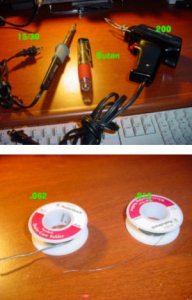Soldering
When I was 13 years old, I got into electronics and radio. My best friends father, K9CHZ, a ham, said. " Andy if you want to get into radio and electronics. You need to learn the principles of soldering". Now I am passing what I have learned to you.
First is the differant types of irons and gun. There is no general purpuse tool. Do you work with pc boards or wire or both? Working with pc boards and electronic components. You need very little heat. All you need is about 15 watt iron. If you work with CMOS electronics. Make sure it is gounded. CMOS components are very static electrity sensitive.
If you solder small gauge wire. Such as the wires on Atlas's switch track. A 30 watt iton is good.
Know with at gun. Soldering heavier gauge wire is what I use with mine. I use mine most for Ham Radio. I solder PL-259 coax connectors with it. It is very handy to burn off emale of 32 gauge wire! Plus I use it to solder spade connectors to 10 - 15 gauge wires.
The butan unite I baught because I was tired of dragging an extension cord out when I was working on my antennas outside. I've even used it out side in a Wisconsin snow sorm to fix an antenna!
No the solder. I use 2 differant size. The .015 dia. is used on pc boards. I also have .062 for soldering connectors and wire together. Make sure you do use "electronic" solder.
If you use solder with a rosin core. You will have no problems. Sometime solder has a hard time attacting and flows right off the joint. You are lacking flux or the connection needs cleaning. You can buy a tube of solder flu at Radio Shack.
I normally wont advertise for Radio Shack because I haven't been too happy with them in recent years. If you are not sure what solder to buy. Go there. They have their solder marked pretty good. If you go to Home Depote or other store. You may get the wrong stuff.
Here's an easy rule to remember. Small electronics and wire requires small solder and small amounts of heat. Large wire and connectors require larger amounts of heat and solder. I hope this helps.
Andy






